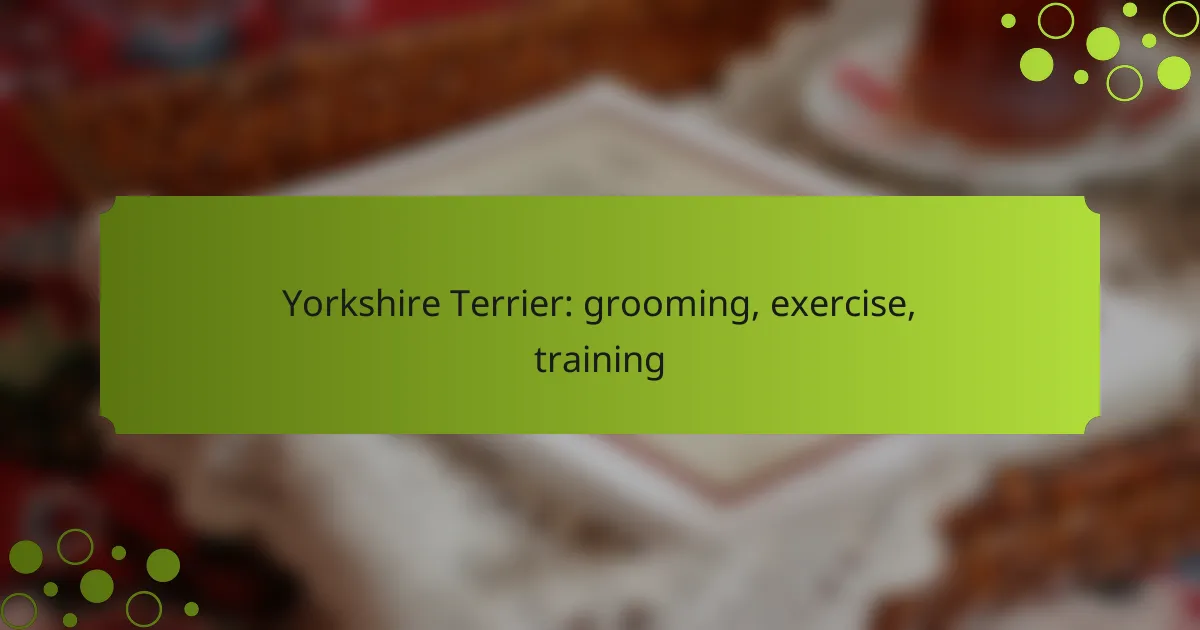Yorkshire Terriers are charming companions that require dedicated grooming, exercise, and training to thrive. Regular brushing and bathing are essential to maintain their beautiful coat and prevent matting, while daily exercise helps keep them healthy and well-behaved. Training these intelligent yet sometimes stubborn dogs demands patience and positive reinforcement for the best results.

How to groom a Yorkshire Terrier in Canada?
Grooming a Yorkshire Terrier in Canada involves regular brushing, bathing, and trimming to maintain their distinctive coat and overall health. Due to their long, fine hair, consistent grooming is essential to prevent matting and ensure cleanliness.
Brushing techniques
Brushing a Yorkshire Terrier should be done at least two to three times a week to prevent tangles and mats. Use a slicker brush or a pin brush to gently work through their hair, starting from the roots and moving towards the tips. Be particularly careful around sensitive areas like the ears and underbelly.
For dogs with more severe matting, consider using a dematting tool or seeking professional help. Always brush in a calm environment to make the process easier for your pet.
Bathing frequency
Bathing a Yorkshire Terrier should typically occur every three to four weeks, depending on their activity level and coat condition. Use a gentle dog shampoo specifically formulated for long-haired breeds to avoid skin irritation. Ensure you rinse thoroughly to remove all soap residue.
In between baths, you can use a damp cloth to wipe down their coat and keep it fresh. Avoid over-bathing, as this can strip natural oils and lead to dry skin.
Trimming and styling
Regular trimming is essential for Yorkshire Terriers to maintain their coat’s health and appearance. Aim for a trim every six to eight weeks, focusing on areas like the face, paws, and tail. You can choose to keep their coat long or opt for a shorter “puppy cut” for easier maintenance.
Consider visiting a professional groomer if you’re unsure about trimming techniques. They can also provide styling tips that suit your dog’s personality and lifestyle.
Ear and eye care
Ear and eye care are crucial for Yorkshire Terriers to prevent infections. Check their ears weekly for dirt or wax buildup and clean them with a vet-recommended ear cleaner. Avoid using cotton swabs, as they can push debris further into the ear canal.
For eye care, regularly wipe away any discharge with a soft, damp cloth. If you notice excessive tearing or redness, consult your veterinarian for advice.
Nail clipping tips
Nail clipping should be done every three to four weeks to prevent discomfort and potential injury. Use a quality dog nail clipper and be cautious not to cut into the quick, which can cause bleeding. If your dog has dark nails, trim small amounts at a time to avoid hitting the quick.
Consider using a nail grinder as an alternative to clippers for a smoother finish. If you’re unsure, ask a professional groomer or veterinarian to demonstrate proper techniques.

What exercise do Yorkshire Terriers need?
Yorkshire Terriers require regular exercise to maintain their health and prevent behavioral issues. Daily activities should include both structured walks and playtime to keep them physically and mentally stimulated.
Daily walking requirements
Yorkshire Terriers typically need about 30 minutes of walking each day, which can be split into two shorter sessions. These walks help burn off energy and provide essential socialization opportunities. Ensure the leash is secure, as these small dogs can be quick and curious.
Playtime activities
Engaging your Yorkshire Terrier in playtime activities is crucial for their well-being. Interactive games like fetch or tug-of-war can be very effective. Aim for at least 15-30 minutes of play each day, adjusting based on your dog’s energy levels.
Indoor exercise options
When outdoor conditions are not ideal, indoor exercise can keep your Yorkshire Terrier active. Set up obstacle courses using household items or engage them with puzzle toys that challenge their minds. Short bursts of play, such as chasing a ball or a feather toy, can also be beneficial.

How to train a Yorkshire Terrier effectively?
Training a Yorkshire Terrier effectively involves consistent methods, positive reinforcement, and patience. These small dogs are intelligent but can be stubborn, so employing engaging techniques is crucial for successful training.
Basic commands training
Start with essential commands such as “sit,” “stay,” and “come.” Use treats or praise as rewards to encourage your Yorkshire Terrier to follow commands. Training sessions should be short, around 5 to 10 minutes, to keep their attention focused.
Repetition is key; practice commands daily to reinforce learning. Gradually increase the difficulty by introducing distractions or practicing in different environments to ensure your dog responds reliably.
Housebreaking strategies
Housebreaking a Yorkshire Terrier requires a consistent schedule for bathroom breaks. Take your dog outside frequently, especially after meals, playtime, or waking up. Praise them immediately after they relieve themselves outdoors to reinforce the behavior.
Consider using a crate as a training tool, as dogs naturally avoid soiling their sleeping area. Ensure the crate is appropriately sized and never leave your dog confined for extended periods.
Socialization techniques
Socializing your Yorkshire Terrier is vital for developing a well-adjusted pet. Expose them to various environments, people, and other animals from a young age. Positive experiences will help reduce fear and anxiety in new situations.
Enroll your dog in puppy classes or arrange playdates with other dogs to enhance their social skills. Always supervise interactions and reward positive behavior to encourage confidence and friendliness.

What are the grooming tools for Yorkshire Terriers?
Grooming tools for Yorkshire Terriers are essential for maintaining their distinctive coat and overall health. Key tools include brushes, shampoos, conditioners, and nail care equipment tailored to their specific needs.
Recommended brushes
For Yorkshire Terriers, a slicker brush and a pin brush are highly recommended. The slicker brush helps remove tangles and mats, while the pin brush is effective for smoothing the coat and distributing natural oils.
When brushing, aim for at least two to three times a week to prevent matting. Regular grooming not only keeps their coat healthy but also allows you to check for skin issues or parasites.
Shampoos and conditioners
Choose a gentle, hypoallergenic shampoo specifically formulated for dogs, as Yorkshire Terriers have sensitive skin. Look for products that are free from harsh chemicals and fragrances to avoid irritation.
Conditioners are also important for maintaining coat softness and manageability. A good conditioner can help prevent tangles and keep the coat shiny. Aim to bathe your Yorkie every four to six weeks, adjusting based on their activity level and coat condition.
Nail clippers and grinders
Regular nail care is crucial for Yorkshire Terriers to prevent discomfort and mobility issues. Use a pair of dog nail clippers or a nail grinder designed for small breeds to keep their nails trimmed.
Check their nails every few weeks, trimming them as needed. If you’re unsure about how much to cut, it’s safer to trim small amounts regularly rather than cutting too much at once, which can cause bleeding.

What are common health issues in Yorkshire Terriers?
Yorkshire Terriers are prone to several health issues that owners should be aware of. Understanding these common problems can help in early detection and management, ensuring a healthier life for your pet.
Dental problems
Dental problems are prevalent in Yorkshire Terriers due to their small mouths, which can lead to overcrowding of teeth. This often results in plaque buildup, gingivitis, and tooth loss if not properly managed.
Regular dental care is essential. Brush your Yorkie’s teeth several times a week and consider professional cleanings at the vet’s office to prevent serious dental issues.
Patellar luxation
Patellar luxation, or dislocated kneecaps, is a common issue in Yorkshire Terriers. This condition can cause limping or skipping while walking, and it may lead to arthritis if left untreated.
To manage this condition, consult your veterinarian for a proper diagnosis and treatment options, which may include weight management, physical therapy, or surgery in severe cases.
Skin allergies
Skin allergies are another frequent concern for Yorkshire Terriers, often triggered by environmental factors like pollen, dust mites, or certain foods. Symptoms include itching, redness, and hair loss.
Identifying the allergen is crucial for effective treatment. Regular vet check-ups can help pinpoint allergies, and your vet may recommend hypoallergenic diets or medications to alleviate symptoms.

How to choose the right food for a Yorkshire Terrier?
Choosing the right food for a Yorkshire Terrier involves selecting high-quality ingredients that meet their specific nutritional needs. Look for dog food that lists meat as the first ingredient and is formulated for small breeds to ensure optimal health.
Consider their age and size
Yorkshire Terriers have different dietary needs based on their age and size. Puppies require food that supports growth, while adults need a balanced diet to maintain their weight. Senior dogs may benefit from lower-calorie options that support joint health.
Look for high-quality ingredients
When selecting food, prioritize brands that use real meat, whole grains, and vegetables. Avoid products with fillers like corn and soy, as they provide little nutritional value. Reading labels can help you identify the best options for your dog.
Check for AAFCO approval
Ensure the dog food meets the standards set by the Association of American Feed Control Officials (AAFCO). This approval indicates that the food provides complete and balanced nutrition for your Yorkshire Terrier’s life stage.
Monitor their health and adjust as needed
Regularly assess your Yorkshire Terrier’s weight, coat condition, and energy levels to determine if their diet is effective. If you notice any changes, consult your veterinarian to adjust their food or explore new options that better suit their needs.
